The Intel Haswell Refresh Review: Core i7-4790, i5-4690 and i3-4360 Tested
by Ian Cutress on May 11, 2014 3:01 AM ESTGaming on Integrated Graphics
For our integrated graphics testing, we use most of the same gaming tests as our discrete gaming range, but at a lower resolution and quality settings (1280x1024, Low) in order to find a reasonable frame rate. Results are given in terms of average and minimum FPS reported. Each of the three CPUs in our test use GT2 / HD 4600 graphics and the same frequencies, meaning that the only difference is clock speeds and threads available. As a result, this should show us how relevant more cores and more threads are for Intel IGP gaming.
F1 2013
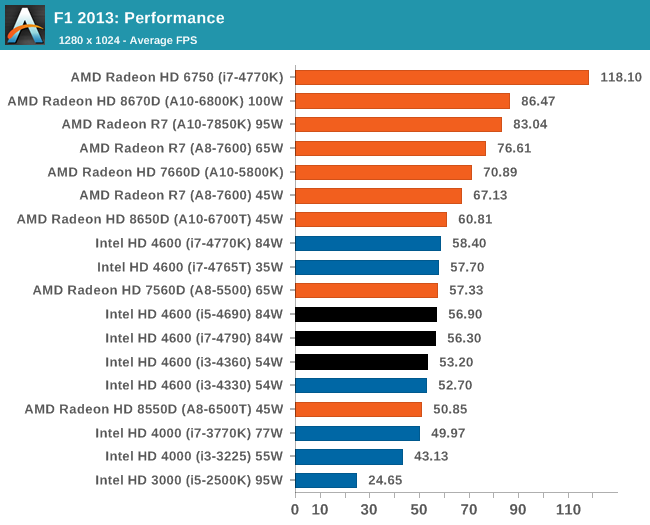
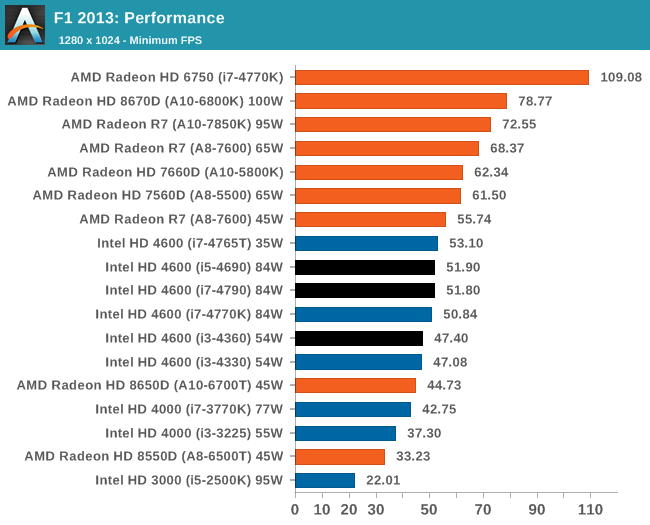
The HD 4600 at 1200 MHz falls just short of 60 FPS average on F1 2013, and moving up from the i3 seems to offer a 6% increase in minimum frame rates.
Bioshock Infinite

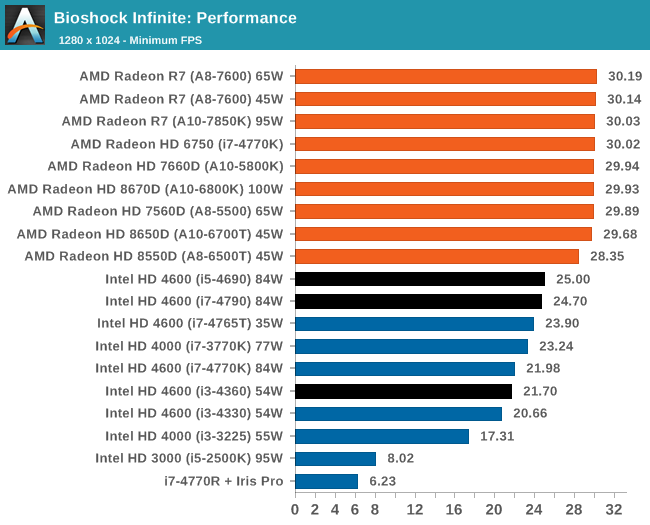
Bioshock Infinite seems memory bound a little, given how good Iris Pro is compared to the HD 4600 scores. There is almost a 10% jump from i3 to i5 here on average FPS and almost 20% in minimum FPS.
Tomb Raider
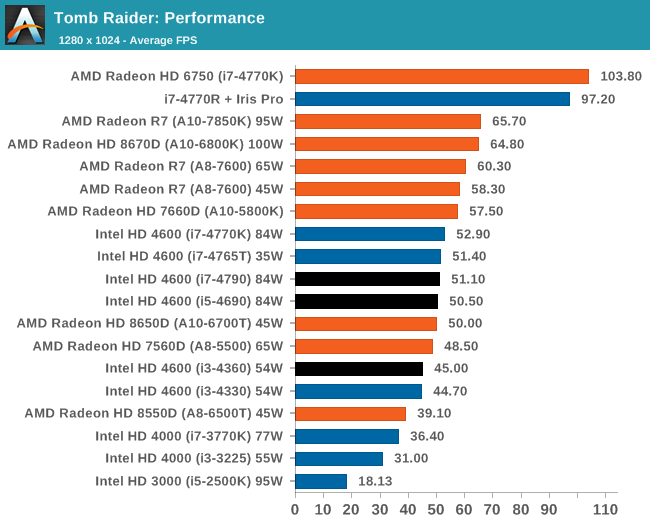
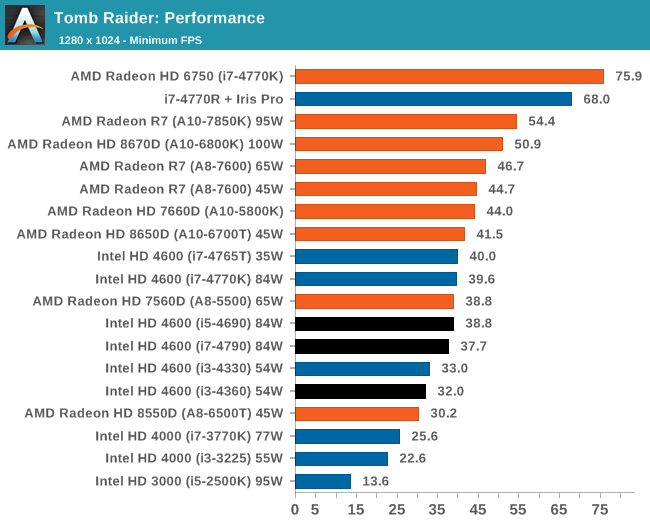
Tomb Raider with discrete GPUs is characteristally CPU agnostic, however moving from an i3 to an i5 gives and extra 5.5 FPS on average in our test.
Sleeping Dogs
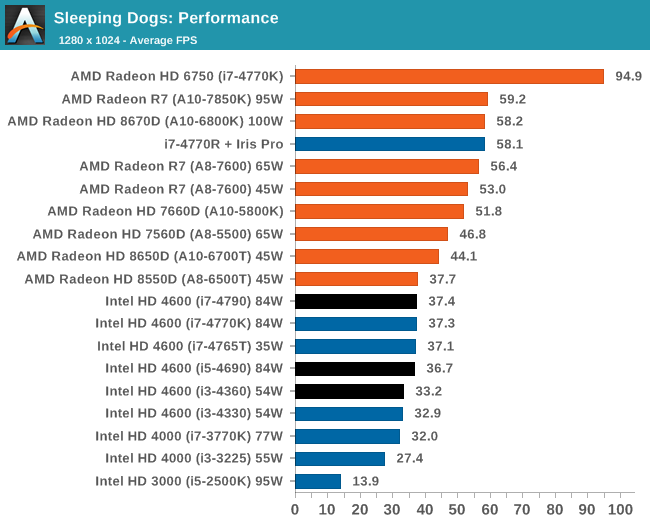

Company of Heroes 2

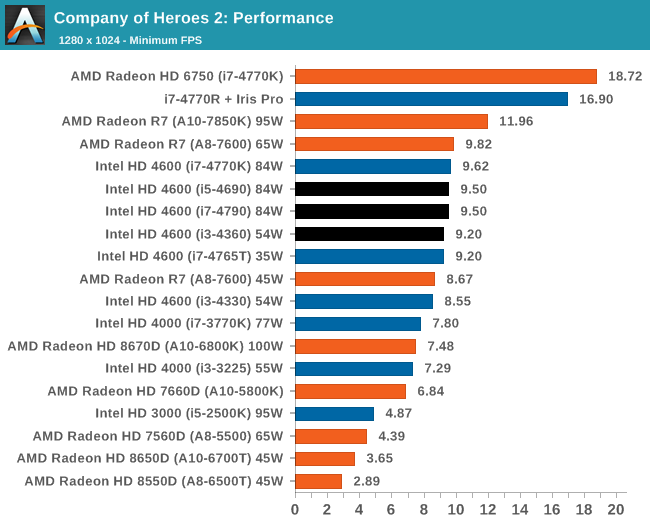
No IGP solution is that well prepared for COH2, although some AMD CPUs and Iris Pro do hit above 20 FPS. We may have to wait another generation to make it more playable and hit 30 FPS at our resolution settings.










130 Comments
View All Comments
willis936 - Sunday, May 11, 2014 - link
Man why are you reading anantech if you think redundant data collection is a waste of time? Verification of both results and of expectations in new products is valuable. Intel could call it a refresh after botching every wafer in the past six months and dump it into a new product line.DanNeely - Sunday, May 11, 2014 - link
This is the locked, non OC, portion of the Haswell refresh. The new unlocked chips have a rumored ETA of early next month.If you're not interested; go read something else instead. What you want isn't available yet.
Flunk - Monday, May 12, 2014 - link
Proving there is no credible difference is useful, maybe it will save some people a few bucks.nutjob2 - Sunday, May 11, 2014 - link
Intel is chasing a dying market, ie, those who are willing to pay for single threaded performance at any cost, and worry less about power consumption, in the desktop and server space.These people fall into two broad categories:
First there are gamers with more money than sense who spend hundreds or thousands each year on the latest CPU/motherboard/GPU that delivers a 5%-10% increase in framerate. Also other people who feel they need the latest and greatest for whatever reason.
On these people Intel dumps their hottest parts since they're not very concerned about power consumption, water cooling is a badge of honor for these guys.
Then there are the corporates who are visited by HP/Dell/etc salesmen and are told they need big, big iron so they can virtualise all their servers to "save money". That of course means they've created a single point of failure for all those servers so they need a machine with redundant everything and huge density. No-one has the heart to tell them they still have a single point of failure.
These people don't so much care about power consumption than the fact you can't cool or deliver power very well to multiple processors in a box, so Intel give them their somewhat cooler parts. Because most of the software they run is not very clever and largely single threaded they stick to Intel.
The smart corporate money is not buying any of Intel's overpriced CPUs instead they're sticking with their existing hardware and waiting for "cloud" providers to lower their prices. Why are they doing that? Because Intel is playing most of the above market for suckers, making them pay through the nose while they sell their best parts to Amazon, Google, Microsoft, IBM et all who pay a fraction of what everyone pays. Intel doesn't do this out of the kindness of their hearts but because they know that cloud providers will eventually replace many of their existing direct customers and because they don't care about single threaded performance (they're almost always using all their cores). Intel are milking their cash cows while they kiss up to the new big players, lest they start getting too friendly with AMD or ARM vendors who can make custom parts for them, just like the big players make their own motherboards, etc shutting out people like HP and Dell.
willis936 - Sunday, May 11, 2014 - link
Adding an extra 20 to product numbers is "chasing"?betam4x - Sunday, May 11, 2014 - link
Regarding your comments:1) Gamers don't spend 'hundreds of thousands of dollars every year' on PC components. Top of the line PC hardware can be had for under 3 grand. Typically the users who buy this years new hardware are the ones that skipped the past 1-2 generations of hardware.
2) Intel's parts aren't 'hot'. They are more power efficient than they've ever been. The performance per watt is among the highest in the industry.
3) Virtualizing does save money. Even if that server went up in flames, a backup of that VM is stored elsewhere so that it can be quickly brought back up on the backup server located in another rack. This means minutes of downtime instead of hours.
4) At my company we buy intel CPUs every day. We upgrade all of our machines every 3 years and often have to buy new machines for new employees. Of course, we do other 'crazy' things as well, like dual monitors, ample workspace, etc. Imagine that?
Gigaplex - Monday, May 12, 2014 - link
"Gamers don't spend 'hundreds of thousands of dollars every year' on PC components."They said hundreds OR thousands, not "of".
rajod1 - Friday, May 30, 2014 - link
Gamers as a group spend millions on upgrades not hundreds or thousands.maximumGPU - Tuesday, May 13, 2014 - link
Upgrade every 3 years, and new machines for new employees? I'd like to apply to a job in your company, tired of XP and pentium 4's in my current one.YuLeven - Wednesday, May 14, 2014 - link
Know that feel. I use a Celeron D here.